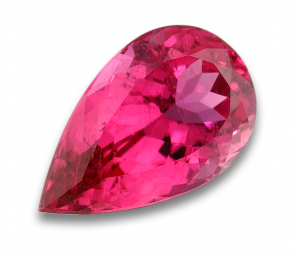 Tourmaline is most known for the broad and dynamic range of colors in which it can be found. This palette, from crisp greens and blues to deep pinks, purples, reds and every color in between, is how Tourmaline is most commonly showcased within the modern jewelry industry. Tourmaline, in their finest examples, are barely included and showcase intense transparent color.
Tourmaline is most known for the broad and dynamic range of colors in which it can be found. This palette, from crisp greens and blues to deep pinks, purples, reds and every color in between, is how Tourmaline is most commonly showcased within the modern jewelry industry. Tourmaline, in their finest examples, are barely included and showcase intense transparent color.
What are the different types of Tourmaline?
Though there are nearly a dozen species, there are three main species most commonly known under the Tourmaline name.
- Elbaite species: This group is the species that is usually seen in jewelry. This species includes rubellite (ranging from red to pink), indicolite (blue to green), verdelite (Green) and, rarely, achroite (colorless). Though the Elbaite species is what eventually made Tourmaline famous in its usage for modern jewelry, it is not the most common of the Tourmaline species. The elbaite group derives its name from the small Italian island known as Elba where these stones and their heavy lithium makeup were first thoroughly chemically examined.
- Schorl species: This is the most common tourmaline species to be found in nature. Schorl tourmalines are typically black, sometimes with a blue or brown tint. These Tourmaline are estimated to comprise up to 90% of the tourmalines on the planet, though these are not the stones typically used in the gem and jewelry industry. Their coloration is caused by large quantities of iron in their chemical makeup.
- Dravite species: These stones, being rich with magnesium, are characterized by dark colors ranging from dark brown yellow to brown black. Because of their lack of brilliance and not being very transparent or reflecting much light, these stones, like those of the schorl species, are not commonly used in jewelry.
What are the Common Cuts for Tourmaline?
Tourmalines are typically cut as faceted gemstones, though they can also be seen as cabochons and slices. You may also find them, uncut and unpolished, as an intact crystal column in contemporary jewelry. Heavily included and cloudy pieces of Tourmaline are sometimes carved.
Tourmaline is known for its ability to grow with multiple colors in once crystal. These are cut into popular color transitioning facetted stones. When they include two, three or more colors in a single crystal, they are known as bi-, tri-, and parti- colored stones.
A common cut, known as “watermelon” Tourmaline, is a stone that transitions from verdilite to rubellite. The resulting stone, with green and deep pink colors sitting either side by side or one within the other, are what give this stone its “watermelon” nickname. These multi-colored stones are very popular in the jewelry world. However, for their rarity, they are still comparatively inexpensive.
Where does are best Tourmaline gemstones found?

Considering their chemical complexity, the wide geographical range where Tourmalines are found is impressive. Within the past three decades, major deposits of intense blue green Tourmalines were found in Paraiba, Brazil. These Paraiba Tourmalines are highly sought after for their intense color. Brazil and Africa (Nigeria, Mozambique and Tanzania) are the top producers of Tourmaline. Brazil is most known for producing nearly every color of Tourmaline from its mines. Mozambique has large quantities of indicolite Tourmaline and others similar to the Paraiba Tourmaline of Brazil. Additionally, deposits of fine gemstone quality have been found and mined in Afghanistan, Madagascar, Pakistan, Sri Lanka and the United States (California and Maine).
What are the characteristics of Tourmaline?
Refractive index: generally 1.62 – 1.64 +/-
Moh’s Scale of Mineral Hardness: 7-7.5
Specific gravity: 3.06 (+.20 -.06)
Very general example of Tourmaline’s chemical composition – X1Y3Al6(BO3)3Si6O18(OH)4
Where: X = Na and/or Ca and Y = Mg, Li, Al, and/or Fe2+
Tourmaline has one of the most complicated chemical formulas. Each species will have its own specific formula to account for the chemicals, minerals and elements present that cause the varied coloration found in Tourmaline
Is tourmaline good for an engagement Ring?
The short answer is no. Engagement rings are often worn daily and can often come into contact with other objects. Whilst Tourmaline is found in fine jewelry, as it lends itself easily to setting in silver, gold and platinum. Tourmaline is basically as hard as quartz; however, it is brittle and should be used cautiously. Due to its delicate nature, it should be worn with care in pieces of jewelry that will come in constant contact from daily wear such as rings and loose bracelets. Tourmaline, thus, is better suited for jewelry pieces that will not run the risk of abrasion through contact. Safe bets are pendants, necklaces, earrings and structured, cuff bracelets. If you are considering Tourmaline jewelry, keep in mind where and how it will be worn and you’ll be able to enjoy your Tourmaline jewelry for years to come!
Tourmalines are a truly beautiful family of gemstones. The wide range of colors available make for a variety of possible jewelry looks. From pale pinks to brilliant blues, these stones will captivate you with their intensity and vibrancy!
